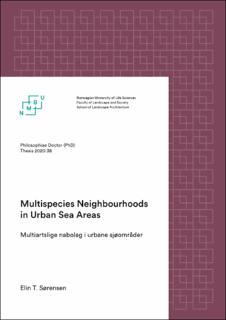| dc.contributor.advisor | Geelmuyden, Anne Katrine | |
| dc.contributor.advisor | Blom, Christian | |
| dc.contributor.advisor | Rinde, Eli | |
| dc.contributor.advisor | Nystuen, Johan Petter | |
| dc.contributor.advisor | Hovind, Anne Beate | |
| dc.contributor.author | Sørensen, Elin Tanding | |
| dc.coverage.spatial | Norway, Oslofjorden | en_US |
| dc.date.accessioned | 2021-05-19T09:55:51Z | |
| dc.date.available | 2021-05-19T09:55:51Z | |
| dc.date.issued | 2020 | |
| dc.identifier.isbn | 978-82-575-1702-1 | |
| dc.identifier.issn | 1894-6402 | |
| dc.identifier.uri | https://hdl.handle.net/11250/2755625 | |
| dc.description | “Multispecies Neighbourhoods in Urban Sea Areas” concerns the interface between landscape architecture, marine biology, art and urban development. The explorative action research is motivated by a need to act and to raise awareness of a hitherto invisible landscape—its spatial qualities, colours, the smell of low tide and the myriad of lifeforms within this symbiosis of sea and shore. The aim is to expand the horizon of those building into this watery world. With a desire to co-create diverse and liveable urban bluescapes, the work has emerged in and through a state of wonder.
The compilation thesis comprises various formats: the collection of articles including two written papers and the digital presentation of the immersive art installation “HAV,” staged at the Norwegian BioArt Arena NOBA Vitenparken Campus Ås in 2020-2021. | en_US |
| dc.description.abstract | The point of departure for this landscape architectural research is a seemingly forgotten and invisible landscape: the urban intertidal. The urban sea areas of the inner Oslofjord in Norway are explored through multisensory learning—driven by curiosity and wonder. For example, snorkelling has become indispensable to my investigative practice as a means of connecting with the tidalscape and marine life.
One problem addressed is how the ocean and its coastlines are increasingly densified and cluttered with human infrastructure. These intertidal interventions alter the physical, chemical and biological environment of marine ecosystems and, in the case of current building practices, deprive people of the opportunity for close, tactile contact with the sea. The hardened coastscapes of cities call for diversity, inclusiveness and shoreline softening. A key question in this thesis is how to improve coastal communities through urban development processes that take life below water into consideration: what does it take to get people to invest in an invisible world?
An attitude change is required. Emotion and empathy are essential components of such processes. This thesis builds upon the belief that art can work as a catalyst for change. Within eco-social art strategies, art practitioners try to broaden understanding through active and participatory co-creation, including ethical considerations about human-nonhuman relations. By re/acting with the ongoing developments of the Fjord City, this study builds on such exploratory action research. Given the aim of securing multispecies neighbourhoods, this thesis accordingly relies upon long-term engagements and deep co-creative practices. One way of achieving these conditions is by exploring the possibilities of living laboratories. Site-specific urban experiments, carried out in a one-to-one scale through the shifting seasons and yearly development, potentially provide the opportunity to learn from natural processes and users’ interaction over time. Attempts to initiate living-labs as part of the Fjord City redevelopment sites have served as valuable learning cases.
The thesis argues that we must trust and recognize nature’s capacity for self-design—and let nature-based solutions develop as freely as possible. Extending these ideas from the field of ecological engineering, a new branch of landscape architecture is articulated: a marine landscape architecture and amphibious landscaping which embrace nature’s dynamics in inventive ways. A key question is how to transfer the complexity of nature onto the urban artificial shorelines. By means of digital fabrication, such as photogrammetry, 3-D modelling and additive manufacturing, concrete solutions for a local adaptive landscape architecture practice are explored. | en_US |
| dc.description.sponsorship | Norwegian Institute for Water Research (NIVA), NMBU’s Idea Development Fund and Ard Innovation (NMBU/NIBIO), NMBU's Seed funding for "Interdisciplinary collaboration for sustainability," Norwegian BioArt Arena (NOBA) Vitenparken Campus Ås, NMBU RealTek Prototype Workshop, NMBU Learning Center, Norwegian Technical Porcelain (NTP). The Norwegian Artistic Research Programme (NARP), Lokalsamfunnsordningen (LOK) Public Art Norway (KORO). | en_US |
| dc.language.iso | eng | en_US |
| dc.publisher | Norwegian University of Life Sciences, Ås | en_US |
| dc.relation.ispartofseries | Ph.D. Thesis;2020:38 | |
| dc.rights | Attribution-NonCommercial-NoDerivatives 4.0 Internasjonal | * |
| dc.rights.uri | http://creativecommons.org/licenses/by-nc-nd/4.0/deed.no | * |
| dc.subject | Marine landscape architecture | en_US |
| dc.subject | Multispecies neighbourhoods | en_US |
| dc.subject | Multisensory learning | en_US |
| dc.subject | Co-creation | en_US |
| dc.subject | Digital fabrication | en_US |
| dc.subject | Coastal eco-engineering | en_US |
| dc.subject | Urban living laboratories | en_US |
| dc.title | Multispecies neighbourhoods in urban sea areas | en_US |
| dc.title.alternative | Multiartslige nabolag i urbane sjøområder | en_US |
| dc.type | Doctoral thesis | en_US |
| dc.description.version | acceptedVersion | en_US |

